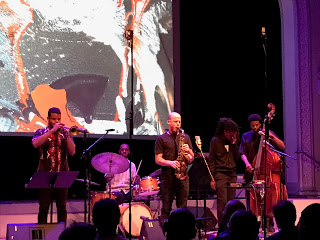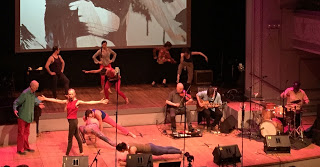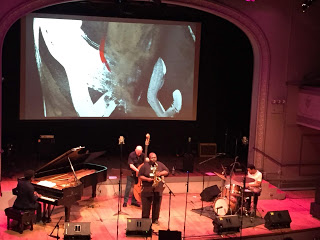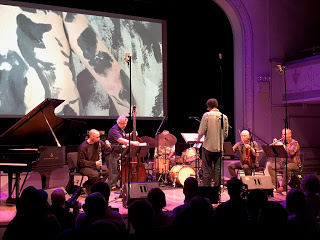By Paul Acquaro and Martin Schray
The line up of Friday night, squarely in the middle of the festival, seemed to showcase musicians at the top of their game – from the young (Irreversible Entanglements) to the established (Daniel Carter).
 |
| Irreversible Entanglements |
And so, it was the young whippersnappers who began the evening. Philadelphia’s Irreversible Entanglements, riding on the success of their 2017 debut album, delivered a rousing set that began with a fanfare of sorts and laid the ground work for Camae Ayewa’s intense poetics. The group has a classic free jazz line up comprised ofq saxophonist Keir Neuringer, trumpeter Aquiles Navarro, bassist Luke Stewart, drummer Tcheser Holmes, and by adding Ayewa’s vocals and electronics, the group becomes a force to reckon with. The instrumental portions are excellent as well, Neuringer and Navarro twist about each others lines, while Stewart an Tscher often reliably lay down a roiling groove. Ayewa’s background in hardcore and punk comes through and her use of politically charged poetry, from which she pulls snippets from her notes and delivers with ferocity and precision. Unfortunately there was a little too much reverb on her vocals – especially at the start – making the words hard to understand. At a previous show I had caught a little while back I recall there being much more poetry (which gave the words much more context) but less band. Tonight, it seemed to be a little in reverse, allowing Neuringer and Navarro time to deliver some intense solo parts of their own.
 |
| Douglass Dunn + Dancers with the Critical Response Trio |
Next up was the Critical Response Trio with violinist Jason Kao Hwang, guitarist Anders Nilsson, and drummer Michael TA Thompson, accompanied by an eleven piece dance troupe. It was fantastic. The trio, whom I had heard once before exactly one year ago at an intimate concert in Beacon, NY, were spot on again. An out curling fractal of abstract musical ideas emanated from the group, centered around Hwang’s heavily effected violin, they dealt our eclectric mix full of shrapnel and beauty, veering from flakes of tonal color to full bodies collective improvisation. The dancers – clad colorfully and moving about the stage in their own improvise synchronizations and stories, made the scene feel like a living Hieronymus Bosch triptych, of bodies twirling about each other, dragging and draping themselves across the stage – the only thing missing were the half-fish people with single crutches! A particular striking moment was when Hwang and Thompson morphed a particularly intense duet into an avant-garde hoedown (wich some of the dancers picked up on).
 |
| Seraphic Light |
Next up was the highly anticipated Seraphic Light trio of Daniel Carter on sax and trumpet, Matthew Shipp on piano, and William Parker on bass. The trio just released a recording, Live at Tuft’s University, which has been receiving critical accolades. The group’s music is a mature statement, one of restraint and patient unwrapping. This night, they began by Carter on trumpet blowing a cool muted tone as Shipp entered with quiet melodic phrases. Parker held long bass notes, and images of a smoky lounge came to mind. Dropping the mute, Carter began playing stronger phrases and Shipp began pawing at the keyboard vigorously. Carter quickly switched to soprano sax, which changed the tonality and direction of the group. In fact, Carter switched again not so long after to the tenor sax, again changing the direction of the music but also revealing the long deep connections between the band members who has been playing together for years in many different permutations. Each episode of music – basically indicated by a switch of instrument by Carter, seemed to be a conscientious cycling through of possibilities. Their music does not disrupt or confront aggressively, it’s light and spellbinding, revealing itself in peeling back layers of melody and motion. Projected behind the group were paintings from Carter’s recently departed partner Marilyn Sontag. It was over all too soon; however, it was great to see Carter, who has for 5 of his 7 decades has
been dedicated to free jazz, on the Vision stage, and supporting a
strong new release.
 |
| Nasheet Waits Equality |
Following the trio was drummer’s Nasheet Waits Equality quartet. While I had no expectations of the group, with Waits, bassist Mark Helias, saxophonist Darius Jones, and pianist Aruán Ortiz, I had no reason to expect less than the absolutely stunning set they played. Waits and Helias began the set quietly and deliberately. Jones then entered with a flutter of high trills and Ortiz punched out a series of tonal clusters. It was a music musical spread, smeary and thick with large gaps giving Oritz a chance to interject. His musical ideas were matched with his physical presence flowing up and down the keyboard, it was a spectacle to see. Waits is a powerful drummer, but also very conscientious of space. A solo mid-way through the set indicated a real change in the group’s overall approach, suddenly opening up the tune, and prompting Jones to drop down into the lower registers of this instrument, eventually leading to a head bopping bluesy passage. Following an exploratory section, Ortiz seized the energy and from the spark of an idea to a fully realized and passionate solo, he led the ensemble back into a ‘spiritual’ moment. The group took this to a music climax that invoked spirits of Coltrane and fire music, providing a musical high for the evening and a sharp contrast to the previous introspective set.
 |
| Matthew Shipp Acoustic Ensemble / Inward Motion |
The evening ended with the Matthew Shipp Acoustic Ensemble / Inward Motion, a band consisting of Shipp (piano, conduction), Michael Bisio (bass), Newman Taylor-Baker (drums), Jason Kao Hwang (violin), Mat Walerian (clarinet) and Nate Wooley (trumpet). Like the evening before it seemed to be a rather formalistic and intellectual project. Shipp said that he wanted to develop springboards for group improvisation that operate outside of his piano-centered groups. The idea was to think in terms of morphing and evolving shapes that included a specific narrative that runs through it, although some of the parts are open for improvisation. Shipp created sonic pathways, vectors and events that can transform in many ways but have a specific destination. The composition itself started with different harmonic cells which appeared to have nothing to do with each other, for example trumpet and clarinet solos, a piano/drums duo, a trio based on a marching rhythm, a drone bass and Wooley’s trumpet floating over it. All these fragments seemed to be isolated until the whole composition flowed into a slow-swinging groove which was foiled by clarinet, trumpet and violin. Finally, the whole beauty of the composition became visible: All the fragments of modern classical music lead to a cool swing beat that turned out to be as solid as a rock, indestructible, shining in all its beauty. If it’s true – as the festival claims – that music can be a healing force, this healing force was presented in the structure of this composition. Beneath the abstract surface there was a tremendous intensity of playing, a marvelous compositional effort was revealed, it was a worthy ending of the best day of the festival so far.
All Vision Festival 23 Reviews:

